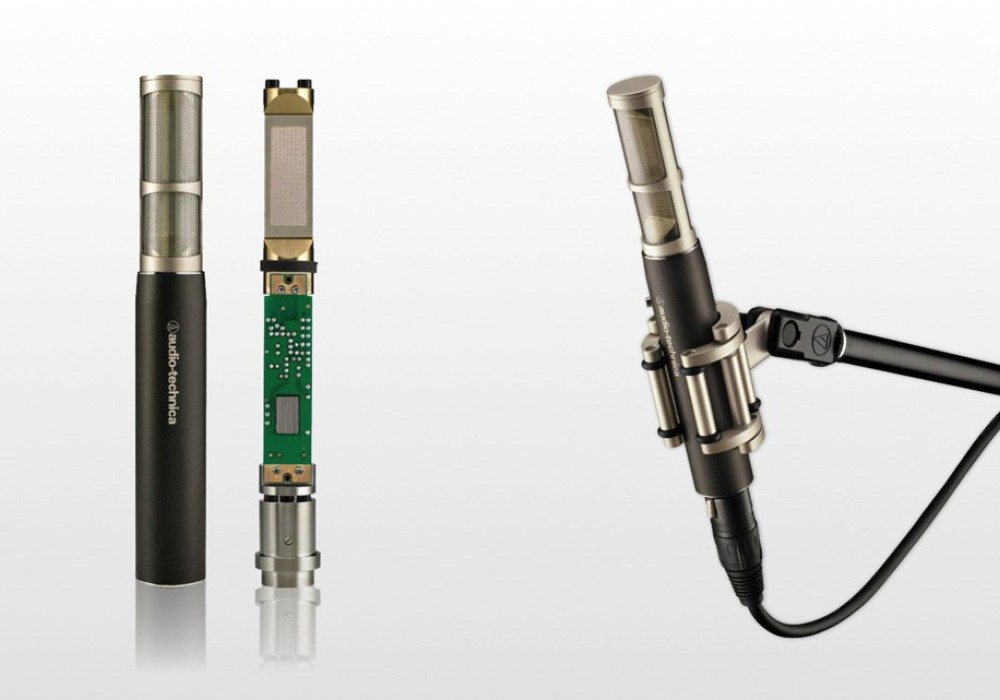Let me start off by saying that I love this mic! It is well-designed, with a number of standout features; and if you buy the stereo kit, it comes with everything you need to get rolling, including a matched pair of the mics. The Starlight is a small-diaphragm pencil condenser with three filter modes, two padding levels, two high-pass settings — and a laser finder that is super convenient. At first, I didn't think I'd use the pointer, but then I found myself turning it on just for kicks and realizing, "Oh my God, the mic is not even pointed where I thought it was!" So now, I think it's a great tool to have onboard — and not just for making sure you aim the mic at the sweet-spot, but also for recall! Another unique feature is the mic's sintered head, made of tiny brass beads formed together. According to Aston, in contrast to a traditional headbasket, the sintered head offers greater acoustic transparency, with fewer basket-borne resonances, more predictable high-frequency response (especially off-axis), and a stronger defense from plosives.
The stereo kit includes a stereo bar, two windscreens, a pair of Rycote shockmounts, and a pair of standard mic clips. Everything comes very handsomely packaged in recycled materials, which is awesome. One thing you might want to do is get a hard-case that's about the same dimensions as the packaging, take all the foam out, and slip it in the hard-case. Then you'll have a nice sturdy box as the cardboard one isn't going to hold up forever.
The Starlight is a rugged mic with a stylish, tumbled stainless-steel chassis. It features a 20 mm cardioid capsule and, according to Aston, "employs an extremely fine-tuned discrete mic amp circuit with high-spec components, to achieve an extremely sensitive, low-noise design with loads of headroom." I found these mics to respond well to subtle changes in proximity and volume when tracking acoustic guitars. I could actually "work" the mic to achieve different levels of emotion in the performance.
The mic's three filter modes choose between Vintage, Modern, and Hybrid voicings. Basically, as you go from Vintage towards Modern, you get high-frequency lift. For example, if you are recording acoustic guitar, the Modern or Hybrid settings may be desirable to emphasize highs. On the other hand, recording a guitar amp that is super bright might call for Vintage mode to tame the highs. I think the Starlight sounds great on electric guitar, especially in Vintage mode, which gives the amp a warm but clear sound.
I found the −10 dB and −20 dB pads super useful, especially for tracking drums. I tried the Starlights as overheads, as well as on snare top, to get a bit of a brighter sound than the typical dynamic. I must say, it sounded cool on snare, especially in tandem with a Shure SM7 [Tape Op #36] blended in. The high-pass switch allows for your choice of moderate or steep cuts. This is definitely cool for removing the typical "rumble" frequencies, or for tracking in a live room where you might not want a ton of low-end kick in your snare or overhead tracks. I will add that these mics are super live and may not be the best in a situation where you're trying to avoid bleed.
The Starlight mics really shine for tracking acoustic guitars. When I set the pair up in an X-Y configuration and flipped the polarity on one of the mics, the center image almost completely canceled out. Switching back to normal polarity, I found the stereo image to be very true to what I was hearing in the room, and the filter and voicing switches allowed me to sculpt the sound without patching in an EQ for tracking.
The Starlight stereo kit is a versatile set of mics and accessories for someone who's looking for a pair of SDCs with a ton of vibe and that aren't one-trick ponies. The mics are solid and have a lot built-in to get you recording quickly, and as I mentioned, the laser finder is super handy. One note about the laser — it uses phantom power, so the mic does not really pass signal when the pointers are on. The Starlights are great mics, and they are now my primary pair of small-diaphragm condensers.





_disp_horizontal_bw.jpg)